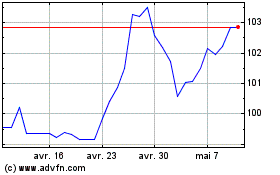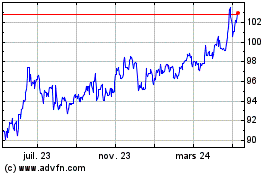Antipodean Currencies Rise Amid Risk Appetite
03 Juillet 2024 - 5:16AM
RTTF2
Antipodean currencies such as the Australia and the New Zealand
dollars strengthened against their major currencies in the Asian
session on Wednesday amid risk appetite, as investors are digesting
U.S. Fed Chair Jerome Powell's speech at the ECB Forum in Portugal,
where he expressed satisfaction with the progress on inflation but
said he wants to see more before being confident enough to start
cutting interest rates.
Powell said that policy makers want to understand whether recent
weaker inflation readings indicate a true picture of underlying
price pressures.
Traders also look ahead to the closely watched monthly U.S. jobs
report on Friday for more clarity about the outlook for Fed
interest rates.
Gains in technology and mining stocks also led to the upturn of
investor sentiment.
The Australian dollar started rising against its major rivals
after the release of retail sales data for May.
Data from Australian Bureau of Statistics showed that
Australia's retail trade rose 0.6 percent in May, followed by a 0.1
percent rise in April. The economists had expected only a rise of
0.3 percent.
In economic news, data from Judo Bank showed that the services
sector in Australia continued to expand in June, albeit at a slower
pace, with a services PMI score of 51.2. That's down from 52.5 in
May, although it remains above the boom-or-bust line of 50.
In the Asian trading today, the Australian dollar appreciated to
a 33-year high of 108.01 against the yen, from yesterday's closing
value of 107.62. The AUD/JPY pair may test resistance near the
109.00 region.
Against the U.S. dollar and the euro, the aussie advanced to
2-day highs of 0.6682 and 1.6082 from Tuesday's closing quotes of
0.6666 and 1.6113, respectively. If the aussie extends its uptrend,
it is likely to find resistance around 0.68 against the greenback
and 1.59 against the euro.
Against the Canada and the New Zealand dollars, the aussie edged
up to 0.9137 and 1.0987 from yesterday's closing quotes of 0.9116
and 1.0966, respectively. On the upside, 0.92 against the loonie
and 1.10 against the kiwi are seen as the next resistance levels
for the aussie.
The NZ dollar rose to 2-day highs of 0.6086 against the U.S.
dollar and 98.33 against the yen, from yesterday's closing quotes
of 0.6078 and 98.12, respectively. The NZD/USD and NZD/JPY pairs
may test resistance around 0.61 and 99.00, respectively.
Against the euro, the kiwi advanced to 1.7664 from Tuesday's
closing value of 1.7674. If the kiwi extends its uptrend, it is
likely to find resistance around 1.74 against the euro.
Meanwhile, the safe-haven yen weakened against other major
currencies in the Asian session, as Asian stock market rose and
also traders looked out for signs of Japanese authorities to
intervene in the currency market to prop up the currency.
Data from Jibun Bank showed the services sector in Japan slipped
into contraction territory in June, with a services PMI score of
49.4. That's down from 53.8 in May, and it falls beneath the
boom-or-bust line of 50 that separates expansion from
contraction.
The yen declined to a 38-year low of 161.88 against the U.S.
dollar and a 16-year low of 205.24 against the pound, from
yesterday's closing quotes of 161.44 and 204.77, respectively. The
yen may test support near 162.00 against the greenback and 206.00
against the pound.
Against the Canadian dollar and the euro, the yen slipped to a
17-year low of 118.30 and a 2-day low of 173.79 from Tuesday's
closing quotes of 118.00 and 173.45, respectively. On the downside,
119.00 against the loonie and 175.00 against the euro are seen as
the next support levels for the yen.
The yen edged down to 178.95 against the Swiss franc, from
yesterday's closing value of 178.56. If the yen extends its
downtrend, the CHF/JPY pair is likely to find support around the
180.00 area.
Looking ahead, Services PMI reports from various European
economies and U.K. for June are due to be released in the European
session.
In the New York session, U.S. mortgage approvals data, U.S.
weekly jobless claims data, U.S. and Canada trade data for May,
U.S. factory orders for May and U.S. EIA weekly crude oil data are
slated for release.
AUD vs Yen (FX:AUDJPY)
Graphique Historique de la Devise
De Oct 2024 à Nov 2024

AUD vs Yen (FX:AUDJPY)
Graphique Historique de la Devise
De Nov 2023 à Nov 2024
